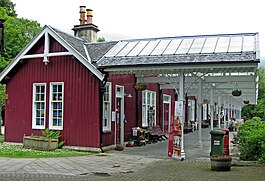Strathpeffer railway station
| Strathpeffer | |
|---|---|

The station in 2011, viewed from the west end, when in use as an information office, cafe and retail shops. The railway line lay behind the bushes at right.
|
|
| Location | |
| Place | Strathpeffer |
| Area | Strathpeffer |
| Operations | |
| Original company | Highland Railway |
| Pre-grouping | Highland Railway |
| Post-grouping | London Midland and Scottish Railway |
| Platforms | 1 |
| History | |
| 3 June 1885 | station opens |
| 23 February 1946 | station closes |
| Disused railway stations in the United Kingdom | |
| Closed railway stations in Britain A B C D–F G H–J K–L M–O P–R S T–V W–Z |
|
|
|
|
Strathpeffer railway station was a railway station serving the town of Strathpeffer in the county of Ross and Cromarty, (later Highland Region), Scotland. The first station was located some distance from the town, on the Dingwall and Skye Railway line, and was opened in 1870.
Seasonal visitors to Strathpeffer increased considerably in numbers, and a branch line to Strathpeffer itself was opened in 1885; the earlier station was renamed Achterneed. Tourism increased considerably, but the First World War interrupted the leisure development, and it never recovered after the war.
In 1946 the second Strathpeffer station was closed to passengers. The earlier station, now called Achterneed, continued in use, being located on a through line, but it closed in 1964.
On 5 July 1865 the Dingwall and Skye Railway was authorised by Act of Parliament; it was an ambitious scheme to build westwards from Dingwall on the Inverness and Ross-shire Railway to Kyle of Lochalsh on the west coast opposite the Isle of Skye.
The part of the route at the eastern end was planned to follow relatively easy terrain, passing through Strathpeffer to Contin, then turning north through the valley of the Black Water to pass Loch Garve.
Sir William MacKenzie of Coul House had opposed the railway on the grounds of loss of privacy at his residence, but Parliament had not upheld his objections. He was implacably opposed to the construction of the railway nearby, and demanded that the line should be built in tunnel throughout the crossing of his lands, an arrangement that the promoters of the line thought impracticable and unaffordable. MacKenzie continued his opposition in such a way that construction could not proceed, and at length the Dingwall and Skye company obtained a second Act, on 5 July 1865, authorising an alternative route. As the proposed line approached Strathpeffer it turned sharply northwards, at the location that later became Fodderty Junction, climbing at 1 in 50 to a local summit at the Raven's Rock (458 feet), there continuing west to meet the originally intended route. These arrangements increased the cost of construction of the line, and made operation more difficult.
Strathpeffer was the largest community on the line of route, with a population of 2,247 in 1861. Notwithstanding the deviation, it was given a station, although this was about two miles north of the town at the top of a steep hill. The line opened to goods traffic on 5 August 1870 and to passengers on 19 August 1870, and this Strathpeffer station opened at the same time. The line was worked by the Highland Railway. Sir William MacKenzie died before the line opened, and his heir was friendly towards railways.
...
Wikipedia
